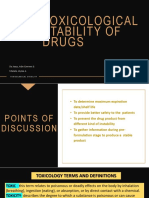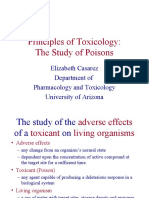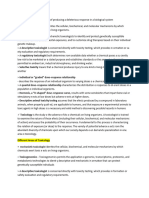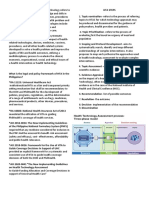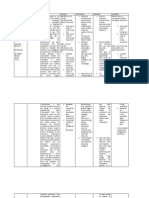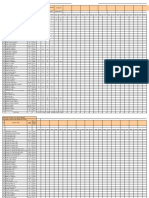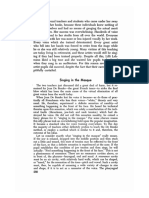Poisons in His Book de Materia Medica (Covers 600 Plants)
Poisons in His Book de Materia Medica (Covers 600 Plants)
Uploaded by
LoiseCopyright:
Available Formats
Poisons in His Book de Materia Medica (Covers 600 Plants)
Poisons in His Book de Materia Medica (Covers 600 Plants)
Uploaded by
LoiseOriginal Title
Copyright
Available Formats
Share this document
Did you find this document useful?
Is this content inappropriate?
Copyright:
Available Formats
Poisons in His Book de Materia Medica (Covers 600 Plants)
Poisons in His Book de Materia Medica (Covers 600 Plants)
Uploaded by
LoiseCopyright:
Available Formats
• Modern toxicology - exogenous agents
• Scientist - explore the mechanisms
• Ebers Papyrus (circ. 1500 B.C.) – oldest writing, poisons including hemlock…
• Book of Job (circ. 1400 B.C.) - poison arrows “For the arrows of the Almighty are within me, Their
poison my spirit drinks; The terrors of God are arrayed against me.”
• Hippocrates (circ. 400 B.C.) - therapy and over dosage
• Theophrastus (370-286 B.C.) - student of Aristotle, De Historia Plantarum
• Dioscorides - Greek physician, first attempt at classifying poisons into plant, animal, and mineral
poisons in his book De Materia Medica (covers 600 plants)
• Sulla - Lex Cornelia (circ. 82 B.C), First law against poisoning, careless dispensers
• Maimonides - Moses ben Maimon, AD 1135-1204, poisonings from insects, snakes, and mad dogs.
(Poisons and their Antidotes, 1198)
• Catherine de Medici - Tested toxic concoction (Onset of action, Potency, Specificity and site of
action, Clinical signs and symptoms)
• Philippus Aureolus Theophrastus Bombastus von Hohenheim Paracelsus (1493-1541) - “ All
substances are poisons; there is none that is not a poison. The right dose differentiates a poison
from a remedy.”
• Toxicology - adverse effects of the chemicals on living organisms
• Toxicologist - trained to examine
• Mechanistic toxicologist - cellular, biochemical, and molecular mechanism
- Data or Mechanistic data are used as reference to design and produce safer chemicals
• Descriptive toxicologist - information for safety
• Regulatory toxicologist - deciding on the basis of data provided by descriptive and mechanistic
toxicologist, Regulates the availability of chemicals
• Forensic toxicologist - medicolegal aspects
• Clinical toxicologist - uniquely associated with toxic substances
• Environmental toxicology – pollutants
• Developmental toxicology - developing organism that result from exposure to chemicals
• Reproductive toxicology - the male and female reproductive system
• Poison - deleterious response
• Spectrum of Undesired Effects - Only one effect is associated with the primary objective of the
therapy
• undesirable or side effects – other effects
• Allergic Reaction - hypersensitization, allergic reaction, & sensitization reaction
• Idiosyncratic reaction - abnormal reactivity to a chemical, extreme sensitivity at low doses
• Immediate toxicity - rapidly after a single administration
• Delayed toxicity - lapse of some time
• Reversible versus Irreversible Toxic Effects - affected tissue can regenerate
• Local effects - between biological system and the toxicant
• Systemic effect - absorption and distribution
• Interaction of chemicals
- Additive effect (1+1=2)
- Synergistic effect (1+1=3) or (1+0=3)
- Antagonism (1+1=0
• Route and site of exposure
- Contact
- Ingestion
- inhalation
• Duration and frequency of Exposure
- Acute – less than 24 hours
- Subacute – repeated for 1 month or less
- Sub chronic – 1 to 3 months
- Chronic – 3 months and above
• Dose-Response Relationship - biological system and the amount of toxicant administered
• Individual dose-response relationship - individual organism
• Quantal dose-response relationship - different doses
• ED50 – Effective dose - elicit a qualitative amount
• LD50 – Lethal dose - death in 50%
•
• Essential nutrients –physiologic function and survival
• Hormesis – no nutritional toxic substances
• Threshold – individual responding is zero.
• Dose-response relationship - exists both quantifiable
• Therapeutic index ( I) - ratio of the dose
• VARIATION IN TOXIC RESPONSES
- Selective Toxicity - injury to one kind.
- Species Differences - different species.
- Individual Differences in Response - large interindividual
• Toxicogenomics - genes and toxicants
You might also like
- 3 Case Study - Ursula CtsDocument18 pages3 Case Study - Ursula Ctsapi-435636207100% (1)
- Empanelment List of Gynecology - West BengalDocument40 pagesEmpanelment List of Gynecology - West BengalKriti Kumari67% (3)
- Pharma Lecture FinalDocument75 pagesPharma Lecture Finalibriane eveNo ratings yet
- Adaptogens: Herbs for Longevity and Everyday WellnessFrom EverandAdaptogens: Herbs for Longevity and Everyday WellnessRating: 5 out of 5 stars5/5 (1)
- 1-St-Introduction To ToxicologyDocument27 pages1-St-Introduction To ToxicologyMuhamad Hibban100% (3)
- Briana Parish Unofficial Transcripts Csu ChicoDocument3 pagesBriana Parish Unofficial Transcripts Csu Chicoapi-323574415No ratings yet
- The Neonatal Intensive Care Unit-2Document28 pagesThe Neonatal Intensive Care Unit-2api-457873289No ratings yet
- Resume RNDocument2 pagesResume RNCarpz DarpzNo ratings yet
- Meditation ScriptDocument2 pagesMeditation ScriptAlolika ChakrabortyNo ratings yet
- Chapter 2: Principles of ToxicologyDocument84 pagesChapter 2: Principles of ToxicologyLogeshwaran Ramalingam SNo ratings yet
- Basic Concepts in Toxicology - FDocument90 pagesBasic Concepts in Toxicology - FKhokonNo ratings yet
- Principles of ToxicologyDocument25 pagesPrinciples of ToxicologyHusam ShawaqfehNo ratings yet
- Lecture 1 - Principles of ToxicologyDocument119 pagesLecture 1 - Principles of ToxicologyTae-In LeeNo ratings yet
- Intro To ToxicologyDocument20 pagesIntro To Toxicologyaraine humesNo ratings yet
- Intro To Toxicology Oct15Document21 pagesIntro To Toxicology Oct15DemaNo ratings yet
- Introduction To Toxicology and Food ToxicologyDocument15 pagesIntroduction To Toxicology and Food ToxicologyCn BrNo ratings yet
- BranchesDocument29 pagesBranchesDavid OpokuNo ratings yet
- Intro to PharmacologyDocument112 pagesIntro to Pharmacologyadeniranolami088No ratings yet
- 1 Introduction PDFDocument20 pages1 Introduction PDFAll Furqaniya ChannelNo ratings yet
- Toxicology For Activists: Romeo F. Quijano, M.DDocument87 pagesToxicology For Activists: Romeo F. Quijano, M.DRomeo QuijanoNo ratings yet
- Bosh1103 - 3.0 ToxicologyDocument43 pagesBosh1103 - 3.0 ToxicologyAddry AlffianNo ratings yet
- Toxicological Stability of Drugs: de Jesus, Adia Cavrinni G. Manalo, Alyssa ADocument42 pagesToxicological Stability of Drugs: de Jesus, Adia Cavrinni G. Manalo, Alyssa AAlyssa Manalo100% (1)
- Materi 1 Pendahuluan ToksokologiDocument21 pagesMateri 1 Pendahuluan ToksokologiFARUK HOUSENo ratings yet
- Introduction To Pharmacology: Presented ByDocument23 pagesIntroduction To Pharmacology: Presented BySanghmitra MauryaNo ratings yet
- Environmental Medicine 5 Principles of Toxicology1Document70 pagesEnvironmental Medicine 5 Principles of Toxicology1peter kamboleNo ratings yet
- T o X I C o L o G yDocument7 pagesT o X I C o L o G yDennis ValdezNo ratings yet
- MATERI 1 PENDAHULUAN ToksikDocument18 pagesMATERI 1 PENDAHULUAN ToksikIsTi MasiversNo ratings yet
- CPS 2 ToxicologyDocument31 pagesCPS 2 ToxicologyNgọc Hà NguyễnNo ratings yet
- Toxicology, Scope of Pharmacology in Cosmetic TechDocument48 pagesToxicology, Scope of Pharmacology in Cosmetic TechJagruti MaratheNo ratings yet
- ToxicologyDocument19 pagesToxicologybruuhwilliamsNo ratings yet
- ToxicologyDocument3 pagesToxicologyDiah MarianoNo ratings yet
- Principles of Toxicology: The Study of PoisonsDocument42 pagesPrinciples of Toxicology: The Study of PoisonsAgnivesh MangalNo ratings yet
- Toksikologi+dose ResponseDocument45 pagesToksikologi+dose ResponseLilik Zakiya100% (2)
- Sylvia Lab Animals Toxicology ChemistryDocument44 pagesSylvia Lab Animals Toxicology ChemistrySylvia achiengNo ratings yet
- Copy ofDocument94 pagesCopy ofPreetibah PatelNo ratings yet
- Prinsip Uji Bioaktifitas NaturalDocument47 pagesPrinsip Uji Bioaktifitas NaturalVenny Serlindah Ayu PrimadaniNo ratings yet
- Pharmacology and ToxicologyDocument27 pagesPharmacology and Toxicologyokumuenock000No ratings yet
- 01 General Pharmacology History IntroductionDocument10 pages01 General Pharmacology History Introductionpmily100% (1)
- TOXICOLOGY TransesDocument6 pagesTOXICOLOGY TransesTrisha RomeoNo ratings yet
- General ToxicologyDocument57 pagesGeneral ToxicologyOhoodNo ratings yet
- Toxicology_1_PDFDocument62 pagesToxicology_1_PDFMaroful IslamNo ratings yet
- Introduction To Toxicology PDFDocument6 pagesIntroduction To Toxicology PDFHaroon rahamatNo ratings yet
- Basic Toxicology PSPD (2019)Document61 pagesBasic Toxicology PSPD (2019)harisNo ratings yet
- Toksikologi: Pendahuluan: Definisi, Sejarah, Makna, Arti Penting Dan Ruang Lingkup ToksikologiDocument20 pagesToksikologi: Pendahuluan: Definisi, Sejarah, Makna, Arti Penting Dan Ruang Lingkup ToksikologiM.Sidik Ashari100% (1)
- Scope ToxicologyDocument18 pagesScope Toxicologyshubhamatilkar04No ratings yet
- Toxicology IntroductionDocument20 pagesToxicology IntroductionNorhana BarambanganNo ratings yet
- Principles of Toxicology: The Study of PoisonsDocument23 pagesPrinciples of Toxicology: The Study of PoisonsnitishkjhaNo ratings yet
- Acute Subacute ChronicDocument59 pagesAcute Subacute Chronicaziskf100% (1)
- Food ToxicologyDocument49 pagesFood ToxicologyhalaboNo ratings yet
- Toxi Chapter 2Document7 pagesToxi Chapter 2Norhana BarambanganNo ratings yet
- Lecture OneDocument16 pagesLecture Onetalhahanif1008No ratings yet
- Forensic 3 MidtermDocument29 pagesForensic 3 MidtermJerico ManaloNo ratings yet
- Clinical Biochemistry ToxicologyDocument15 pagesClinical Biochemistry ToxicologyCẩm TiênNo ratings yet
- Toxicology DrugsDocument183 pagesToxicology DrugsDenisa-Alexandra MănăstireanuNo ratings yet
- Method of Toxicity Test 1Document59 pagesMethod of Toxicity Test 1Widya AnggrainiNo ratings yet
- 2 Toxicokinetics & ToxicodynamicsDocument32 pages2 Toxicokinetics & ToxicodynamicsLaura RodriguezNo ratings yet
- Toxtutor 1,2Document107 pagesToxtutor 1,2dhefhaNo ratings yet
- Farmakologi Pertemuan 6 ToksikologiDocument131 pagesFarmakologi Pertemuan 6 ToksikologiDeni SatriaNo ratings yet
- Toxicology IntroDocument23 pagesToxicology Introrobin.foton882No ratings yet
- Clinical Toxicology-Group 2Document121 pagesClinical Toxicology-Group 2Dan Yel YangcoNo ratings yet
- Prof. J.A. Swenberg, DVM, PHD: Dept Environmental Sciences and Engineering Rosenau 253 Jswenber@Email - Unc.EduDocument27 pagesProf. J.A. Swenberg, DVM, PHD: Dept Environmental Sciences and Engineering Rosenau 253 Jswenber@Email - Unc.EdusadasonlineNo ratings yet
- General Principles of ToxicologyDocument23 pagesGeneral Principles of ToxicologyHabib DawarNo ratings yet
- Prinsip Toksikologi 2Document37 pagesPrinsip Toksikologi 2Happy AureliaNo ratings yet
- Nature of DrugsDocument53 pagesNature of DrugsJoan PaulineNo ratings yet
- TOXICOLOGYDocument4 pagesTOXICOLOGYIŋterŋatiioŋal ǷwįƞçǯzxNo ratings yet
- Lec1 Intro To Pharmacology PD PK FinalDocument112 pagesLec1 Intro To Pharmacology PD PK Finalchristian redotaNo ratings yet
- Group-1 ReportingDocument16 pagesGroup-1 ReportingLoiseNo ratings yet
- Panic DisorderDocument2 pagesPanic DisorderLoiseNo ratings yet
- Drug Induced ArrythmiaDocument27 pagesDrug Induced ArrythmiaLoiseNo ratings yet
- CPD 2016 Law-RA 10912Document11 pagesCPD 2016 Law-RA 10912LoiseNo ratings yet
- UntitledDocument3 pagesUntitledLoiseNo ratings yet
- Philippine Standard Practice For PharmacistDocument8 pagesPhilippine Standard Practice For PharmacistLoise100% (1)
- The Self Clues From The BrainDocument12 pagesThe Self Clues From The BrainamerywuNo ratings yet
- Dental Guidelines On Prescribing Opioids For Acute Pain ManagementDocument13 pagesDental Guidelines On Prescribing Opioids For Acute Pain ManagementAllison MaassNo ratings yet
- Histomonas MeleagridisDocument7 pagesHistomonas MeleagridisGabriela Pereyra FernandezNo ratings yet
- Acute Pain NCPDocument6 pagesAcute Pain NCPPesky Pescante-MonterolaNo ratings yet
- Kofarest LS SyrupDocument3 pagesKofarest LS SyrupGAUTAMNo ratings yet
- Skeletal Muscle Relaxants and Opioid Drugs1Document7 pagesSkeletal Muscle Relaxants and Opioid Drugs1Yanyan PanesNo ratings yet
- Daftar Nama Obat Dan KomposisiDocument2 pagesDaftar Nama Obat Dan KomposisisonaselviaNo ratings yet
- Mysec Clo AugDocument4 pagesMysec Clo AugAsharam MaharanaNo ratings yet
- Eve TricDocument6 pagesEve TricCalimarea Adrian AndreiNo ratings yet
- Can Stress Cause Hermaphrodite Marijuana PlantsDocument18 pagesCan Stress Cause Hermaphrodite Marijuana PlantsRoy HarperNo ratings yet
- 2014 A Critical Evaluation of The Trigger Point PhenomenonDocument8 pages2014 A Critical Evaluation of The Trigger Point PhenomenonAni Fran SolarNo ratings yet
- Aspiration PneumoniaDocument46 pagesAspiration Pneumoniayasmine abdelkarimNo ratings yet
- Dislocation Shoulder GoodDocument7 pagesDislocation Shoulder GoodZahiera NajibNo ratings yet
- Menstrual IrregularitiesDocument24 pagesMenstrual IrregularitiesVarna MohanNo ratings yet
- The Use of Split-Thickness Versus Full-Thickness Skin Graft To Resurface Volar Aspect of Pediatric Burned Hands: A Systematic ReviewDocument17 pagesThe Use of Split-Thickness Versus Full-Thickness Skin Graft To Resurface Volar Aspect of Pediatric Burned Hands: A Systematic ReviewFelix Hadi NainggolanNo ratings yet
- Blood Pressure Monotoring: Dr. L.P.C.Warnapura 20/04/2013Document29 pagesBlood Pressure Monotoring: Dr. L.P.C.Warnapura 20/04/2013wellawalalasithNo ratings yet
- Q2 Test MAPEH7Document6 pagesQ2 Test MAPEH7Mary CrisNo ratings yet
- Medicinal Qualities of Chanca PiedraDocument8 pagesMedicinal Qualities of Chanca PiedraGerryNo ratings yet
- Saidpur GMDocument6 pagesSaidpur GMbibahabondhonitNo ratings yet
- White and Beige Minimalist Designer Professional CV ResumeDocument2 pagesWhite and Beige Minimalist Designer Professional CV Resumetousifahmed4201No ratings yet
- Chapter 10Document33 pagesChapter 10Irene DidoekNo ratings yet
- Philippines - Emilio Aguinaldo CollegeDocument12 pagesPhilippines - Emilio Aguinaldo Collegeimes123No ratings yet
- Douglas Stanley On Singing in The Masque PDFDocument4 pagesDouglas Stanley On Singing in The Masque PDFBabi The HumanNo ratings yet
- Aseptic Technique: Reference Berry & Kohn's Operating Room Technique 8 Edition, 1996 Mosby-Yearbook, IncDocument11 pagesAseptic Technique: Reference Berry & Kohn's Operating Room Technique 8 Edition, 1996 Mosby-Yearbook, Incyuukichan_26No ratings yet





















